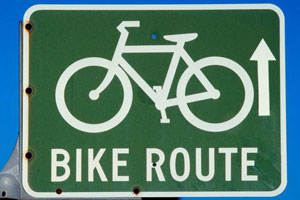Local governments long ago started including bikes in their
transportation plans. But while there are tried-and-true ways of
figuring out automotive traffic patterns, tracking bicyclists can
be more difficult.
By Jason Hoppin
Local governments long ago started including bikes in their transportation plans. But while there are tried-and-true ways of figuring out automotive traffic patterns, tracking bicyclists can be more difficult.
Well, now there’s an app for that.
Building on a program out of San Francisco, the Association of Monterey Bay Area Governments is going high-tech, using next week’s Bike Week to urge bicyclists to help with regional bike planning by downloading a smart phone application that tracks their routes.
“It’s an incredibly useful tool,” said Steph Nelson, a planner with AMBAG.
Called CycleTracks and available for iPhones or Androids, the program uploads trip information, which will be collected and used in future planning efforts. AMBAG is urging cyclists to not only download and use the program, but to enter notes about which types of trips they are taking.
Users can see their routes on CycleTracks, but also see their times and average speed. They can also enter personal information, which is optional.
And Nelson stressed that downloading CycleTracks doesn’t mean the government always has a bead on your location – key after it was recently revealed that the iPhone routinely logs users’ location data.
“If you don’t turn it on, it’s not tracking where you’re going,” Nelson said.
AMBAG hopes to get as many bicyclists as it can from Monterey, San Benito and Santa Cruz counties to download the app. The data would be collected in the fall, and made available to regional transportation planners.
For bicycle planning, governments rely on input from cyclists, who can be vocal about where bike lanes or other infrastructure are needed. But Micah Posner, director of Santa Cruz-based People Power, a bicycle advocacy group, said the program could help.
“I think it would be valuable because bicyclists know what the hotspots are, but we’re relying on the government to make them better,” Posner said.
Bicycle planning is a frequent issue in Santa Cruz County, where a plan to put a trail through Arana Gulch has met controversy and the Regional Transportation Commission’s purchase of a 32-mile coastal rail line is seen by some as right-of-way for future trails, potentially linking with a network of paths along the southern coast of Monterey Bay.
Piet Canin, an Ecology Action vice president who heads a transportation group, said that although the county’s bicycle needs are largely understood, the app could be a useful tool.
“In the long run, definitely, it’s going to be helpful,” Canin said.
While the app was developed by the San Francisco Regional Transportation Authority, Nelson said it works on local routes as well. Funding for the program was provided by the Monterey Bay Unified Air Pollution Control District.









